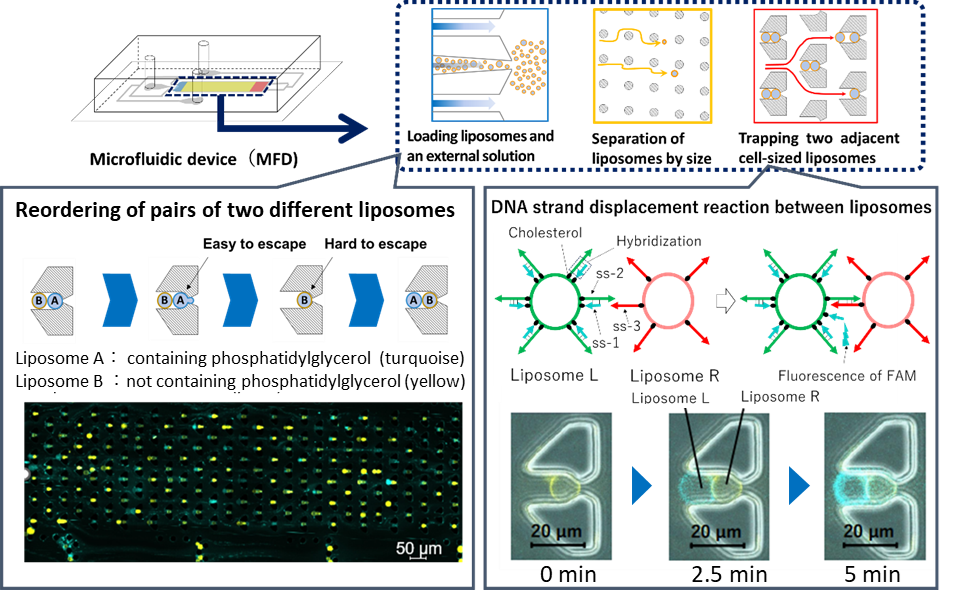O04_04
Investigation on heterogeneous pairs of cell-sized liposomes formed in a microfluidic device
Haruto OBUCHI *1, ZHANG YITING2, Shogo HAMADA3, Keita ABE4, Akihiro INADA5, Teijiro ISOKAWA5, Kaoru UESUGI6, Hironori SUGIYAMA7, Satoshi MURATA4, Taro TOYOTA1, 8
1 Graduate School of Arts and Sciences, Department of Basic Science, University of Tokyo
2College of Science, Rikkyo University
3School of Computing, Tokyo Institute of Technology
4School of Engineering, Tohoku University
5School of Engineering & Graduate School of Engineering, University of Hyogo
6Department of Mechanical Systems Engineering, College of Engeneering, Ibaraki University
7School of Engineering, University of Tokyo
8Universal Biology Institute, University of Tokyo
( * E-mail: haruto-obuchi342@g.ecc.u-tokyo.ac.jp)
Liposomes, which are closed lipid bilayer membranes, have drawn much attention in cosmetics and pharmaceuticals[1,2]. The construction of chemical artificial intelligence (CAI) has recently garnered significant attention in efforts to improve the technologies of diagnostic medicines and artificial organs[3]. The unit of CAI is a complex of three types of functionalized cell-sized liposomes, i.e. sensor, processor, and actuator liposomes, which can mutually transfer chemical information through intermembrane transducer molecules. It remains as a challenge to arrange such three different liposomes in a specific order. We have developed a microfluidic device (MFD) which can simultaneously array multiple cell-sized liposomes to form heterogeneous pairs, which are regarded as signal senders and receivers, and evaluate interactions between the liposomes.
The MFD trapped more than one hundred liposome pairs of uniform size in the microstructures. Interestingly, we observed that under a constant flow pressure, liposomes containing phosphatidylglycerol (liposome A) were forced out of the microstructures preferentially over those without it (liposome B). Therefore, the regulation of the flow pressure for introducing these liposomes enabled us to increase the ratio of number of AB-type liposome pair to those of the others (AA, BA, and BB). Based on this phenomenon, we developed a rearrangement method of liposome pairs in the MFD, by which the formation of the unit of CAI would be realized.
Next, we examined intermembrane DNA strand displacement reaction at the heterogeneous pairs of cell-sized liposomes by the MFD. We separately prepared two kinds of liposome, Liposome L and R, which beard DNA-cholesterol conjugates within the membrane. Liposome L carried hybridized DNA-cholesterol conjugates, ss-1 and ss-2. Conjugate ss-1 has a single strand DNA tagged with a fluorophore called FAM, and ss-2 has a single strand DNA complementary to that of ss-1 and quenches FAM. Liposome R beard conjugate ss-3 the DNA of which is complementary to that of ss-2 and has a longer sequence than ss-1. The sequential introduction of liposome L followed by liposome R allowed the formation of numerous heterogeneous pairs of liposomes L and R in the MFD. An increase in the fluorescence intensity of liposome L in the pair was observed, which means that the DNA strand displacement reaction between hybridized ss-1/ss-2 and ss-3 restored the FAM fluorescence. The current results will lead a novel statistical validation method of two different liposomes carrying DNA-cholesterol conjugates. Furthermore, the results obtained in this study suggest that on-membrane DNA reactions between adjacent cell-sized liposomes can contribute to the construction of a computational system.
[1]Y. Jiang., et al. 2024. Pharmaceutics. 16, 34.
[2]Y. Rahimpour and H,Hamishehkar.2012. Expert Opin. Drug Deliv. 9,4, 443–455.
[3]S. Murata., et al. 2022. Adv. Funct. Mater. 32, 37, 2201866.
